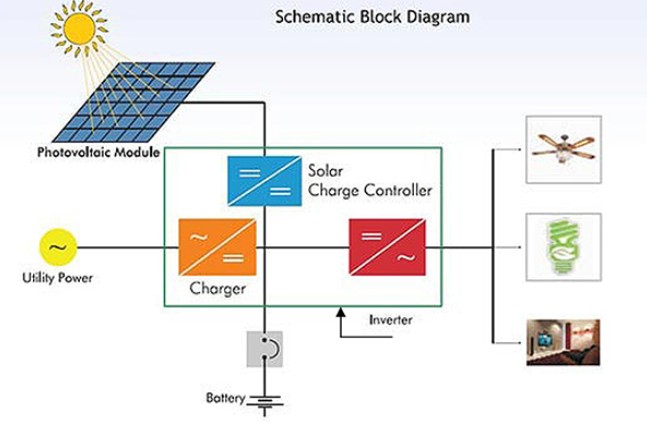Inverters are a crucial part of any solar system installation – be it off-grid or on-grid. But there are many questions that surround them – how does a solar inverter work? why is solar inverter important? what types of solar inverters are there in the market? and how much does the solar inverter cost? This article from SolarClap answers all these questions.
Before we proceed with this topic, I suggest you read about What Is An Inverter? & How Does It Work?
Page Contents
How important is Solar Inverter?
This example explains the importance of solar inverters very well: We all know that we need minerals like Iron, potassium, calcium, etc. These minerals are in the soil in good quantities but can you eat soil? No! Our bodies can’t digest soil. Plants take these nutrients from the soil (besides air, water and sunlight) and convert them into fruit which we can eat and enjoy. Similarly, solar inverters take DC and convert it into AC because our electrical appliances can’t run directly on DC – they need AC.
Now you must be wondering why not DC, why AC? The Alternating Current (AC) is much safer compared to Direct Current (DC) and the loss of energy in transmitting this current to far-off areas is also lesser in the case of AC.
What types of solar inverters are available in India?
There are 3 types of solar inverters in India. These are:
1. Solar Power Conditioning Unit or Solar PCU
Solar PCUs are usually installed with off-grid solar installations. It is an all-in-one unit that has an in-built solar charge controller, inverter and charger, and is connected to a battery bank. It converts the DC electricity generated by panels into AC and feeds it to the main electrical outlet of the house to run the connected load. The extra energy gets stored in batteries to power the load in absence of the sun. It also comes with advanced monitoring software which allows you to measure its performance i.e. units of electricity generated, output waveform, charging current, etc.
2. Solar Grid-tie Inverter
As the name suggests, these inverters are connected to the grid and are used for on-grid installations. They convert DC from solar into AC and power the connected load. The surplus energy generated can be fed back to the grid if the state has provided for this. In states where net-metering has been implemented, you can get paid for feeding the grid depending on the back-back tariff set by the State Government. While grid-tie systems are easy to install and maintain because they are battery-less, they cannot operate in absence of a grid.
3. Solar Hybrid Inverter
This is the latest offering in India’s solar market. Solar hybrid inverters can function both as ordinary inverters and solar inverters because they can operate on-grid as well as solar power. When the sun is up and panels generate DC electricity, it charges the batteries through solar power and when the batteries are fully charged, it disconnects itself from the main grid to power the house with solar energy stored in batteries.
If the panels are not making enough power to charge the batteries then it takes the remaining voltage and current from the grid to make sure that the batteries get charged. During evenings and periods of no sunshine, it functions like an ordinary inverter and charges batteries through the grid.
Read the detailed article here: What Is Hybrid Solar Inverter? And How Does It Work?
How does a Solar Inverter Work?

The job of an inverter is to invert – it takes DC (Direct Current) and converts it into AC (Alternating Current). The solar inverter also does that. When sunlight falls on solar panels, they generate DC electricity. However, we can’t use this DC electricity directly to power our electrical equipment and appliances like fans, lights, refrigerators, AC, heaters, etc. because all these appliances are designed to run on AC. The solar inverter takes DC from solar panels and converts it into AC so that you can run your electrical load.
Also Read: 3 Most Common Myths About Pure Sine Wave Inverters
What is the cost of Solar Inverters in India?
The price of a solar inverter depends on its type and size. A solar PCU of 1000 VA may cost up to Rs.10,000. A 1 kVA on-grid inverter could be priced between Rs. 15,000 and Rs. 20,000. A solar hybrid inverter for home is more economical and costs only Rs. 2,000 more than an ordinary home inverter.
How Long Do Solar Inverters Last?
The life of solar inverters is usually very long. A good branded solar inverter if maintained properly can last more than 10 years.
Also Read: Convert Your Existing Inverter & Battery Into Solar Inverter & Battery
How to Decide the Size of Solar Inverter to match Solar Panels?
The size of the solar inverters depends on the connected load. It is better to keep at least a 25% higher capacity of the inverter than that of the total power ratings of the connected load. Battery sizing depends on the depth of discharge and backup time required to run the connected load in absence of the solar energy or other sources of energy (Grid/DG).
If the total wattage from solar panels is 1000W or 1kw then you need an inverter of typical ratings of 1000W/1250VA (0.8pf) and a battery bank of 300Ah/24V (7200VAh) capacity.
Got Queries? Ask with #SolarClap
